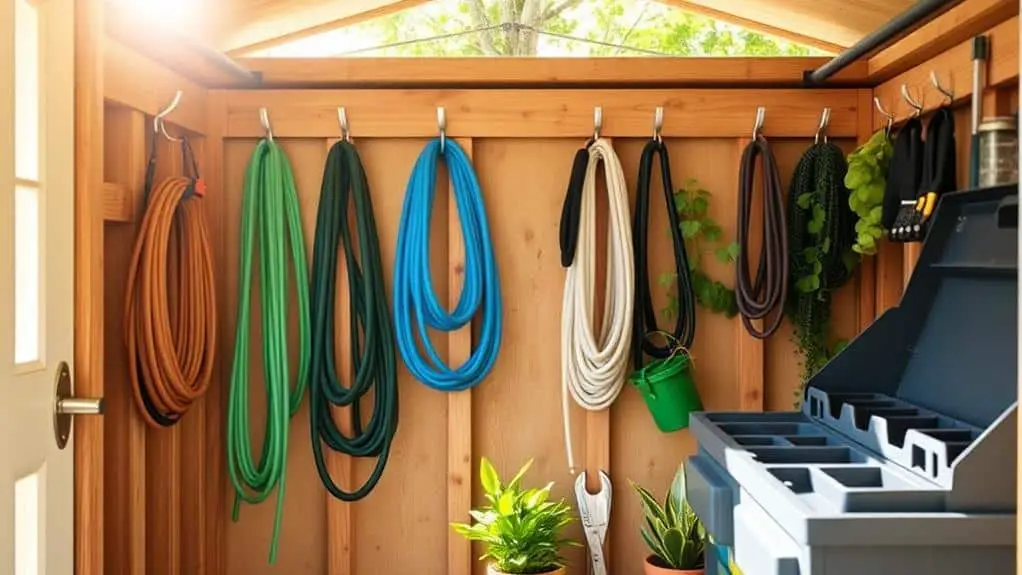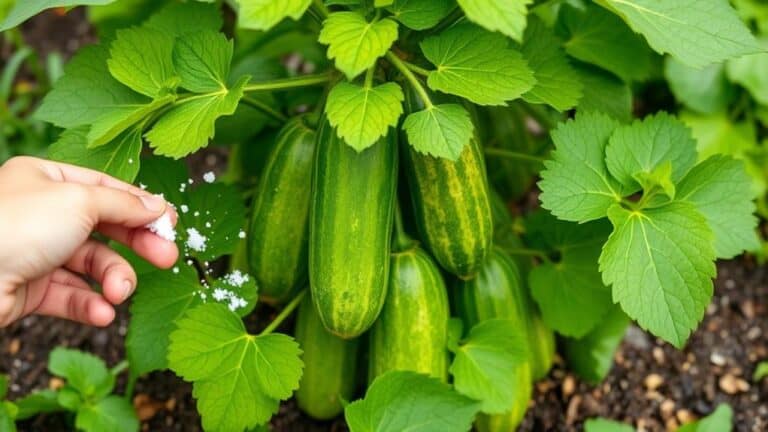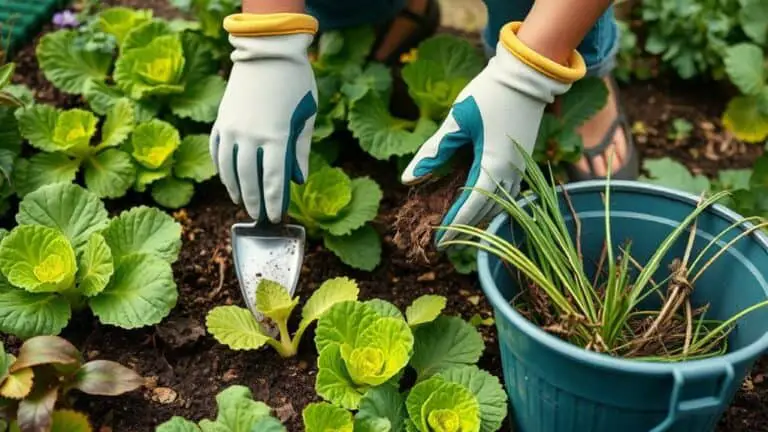Hack To Keep Your Garden Hose And Cords Organized
I've always found that keeping garden hoses and cords organized can be quite the challenge. It's not just about aesthetics; proper storage can greatly extend the lifespan of these items. I've recently discovered a few effective methods, from wall-mounted hooks to hose reels, that can make a world of difference. But there's more to it than just hanging them up—simple techniques like the "over-under" coiling method can prevent annoying kinks and tangles. Curious about how to make your gardening tasks more efficient? Let's explore some practical, easy-to-install solutions together.
Importance of Organization

Anyone who's ever spent time searching for a tangled garden hose or misplaced extension cord knows just how frustrating disorganization can be.
It's vital to recognize the importance of organization when it comes to gardening. By keeping your garden hose and other tools neatly stored, you save time and effort in your gardening tasks.
Proper storage not only extends the lifespan of your equipment by reducing wear and tear but also makes your garden safer by minimizing tripping hazards. An organized space enhances the overall aesthetic appeal of your garden, transforming it into a more inviting place.
Plus, when everything has its place, you're more likely to enjoy and regularly engage in gardening activities, leading to a better-maintained garden.
Common Storage Solutions
When it comes to keeping our garden hoses and cords organized, wall-mounted hooks and hose reels can be real game changers.
Wall-mounted hooks make it easy to hang hoses and cords, so they're always within reach and never tangled.
Hose reels, whether manual or automatic, keep hoses neatly coiled and ready for use, saving both time and frustration.
Wall-mounted Hooks Benefits
For an efficient and clutter-free garden or garage, wall-mounted hooks offer a multitude of benefits that can't be overlooked.
First, they provide easy accessibility to your hose, making it a great storage hack to keep things organized. You won't waste time searching for tools anymore.
Plus, these hooks save valuable ground space, giving your area a neat, chic storage hack look. By holding hoses and cords off the ground, they prevent tangling and damage, which extends the lifespan of your equipment.
Installation is straightforward and cost-effective, requiring only basic tools.
Finally, wall-mounted hooks enhance the aesthetic appeal of your outdoor space, ensuring everything looks tidy and inviting.
Tangle-free Hose Reels
Utilizing tangle-free hose reels can revolutionize the way you manage garden hoses, offering a blend of convenience and efficiency. These reels use a spring-loaded mechanism for easy retraction, preventing kinks and tangles. Wall-mounted hose reels are perfect for saving ground space and can be installed near a water source. Portable hose reels are great for moving around your garden. Decorative hose reels not only keep your garden hose organized but also add a touch of style to your yard. Don't forget, regular maintenance is key for long-lasting functionality.
| Type | Benefit | Best For |
|---|---|---|
| Wall-mounted | Saves ground space, convenient access | Fixed gardening areas |
| Portable | Easy to transport | Multiple gardening areas |
| Decorative | Enhances garden aesthetics | Stylish and functional organization |
| Spring-loaded | Prevents kinks and tangles | Quick and efficient hose storage |
DIY Storage Ideas
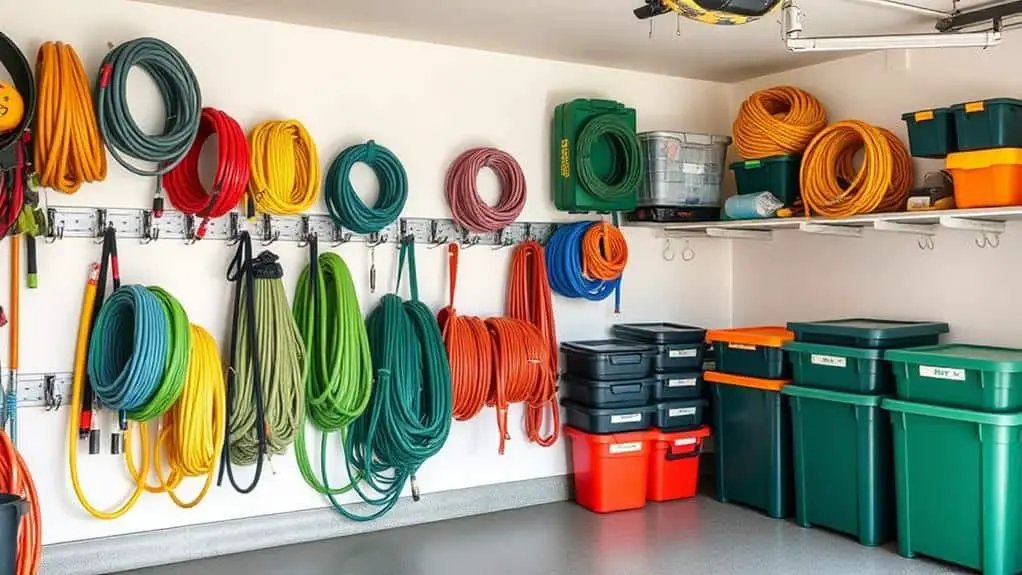
Transforming your garden space into an organized haven doesn't have to be complicated or expensive.
I found some great DIY storage ideas that make managing garden hoses and cords a breeze. Repurposed pallets can be transformed into functional hose racks, adding a rustic touch.
For cords, cutting PVC pipes to size creates an efficient and tidy management system. Wooden crates are also a stylish option, offering stackable storage for added versatility.
Don't forget about magnetic strips; they're perfect for keeping small gardening tools accessible and organized.
Finally, painted buckets can serve as colorful and practical storage solutions, adding a decorative flair to your outdoor space.
These simple ideas can make your garden more organized and enjoyable.
Installation Process
Choosing the right spot for your hose or cord holder is essential to making your gardening tasks easier. First, find a location near a water source or power outlet to keep everything within reach.
Clean the chosen object, like a bucket or old tire rim, to remove dirt and debris. This hack guarantees a stable and hygienic holder.
Next, securely attach the holder to an exterior wall or fence using screws or brackets. Make sure it can support the length of the hose or cord without wobbling.
Test the stability by applying gentle pressure; it should remain firm. This installation process only takes a few minutes, helping you keep your garden organized efficiently.
Maintenance Tips
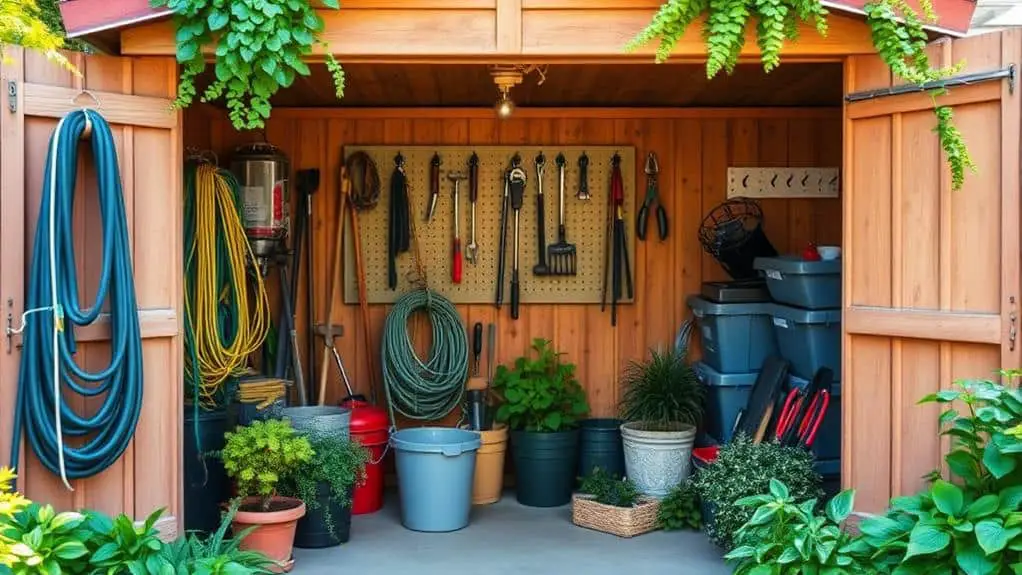
When it comes to keeping your garden hoses and cords in top shape, regular maintenance is key.
First, conducting hose inspections and cord maintenance helps spot early signs of wear, like cracks or fraying, which can prevent leaks and electrical hazards.
Cleaning the storage areas periodically is important, as dirt and debris can affect the longevity of your hoses and cords.
Make certain to store them in dry locations to avoid mold and mildew, especially in humid places.
Use stable racks or holders to prevent accidents and falling equipment.
Finally, rotate your hoses and cords periodically to guarantee even wear, which is essential if you frequently use certain lengths.
These steps make maintenance straightforward and effective.
Safety Considerations
While regular maintenance is essential for the longevity of your garden hoses and cords, ensuring their safe use is equally important.
I can't stress enough the importance of proper hose handling techniques to avoid injuries. Always lift heavy hoses correctly to prevent strain. Trip hazard awareness is critical; make sure to use safety clips to secure hoses in place and keep pathways clear.
Regularly inspecting for leaks is essential for safe operation. Leaky hoses not only waste water but can also create slippery areas that are dangerous.
Draining the Hose
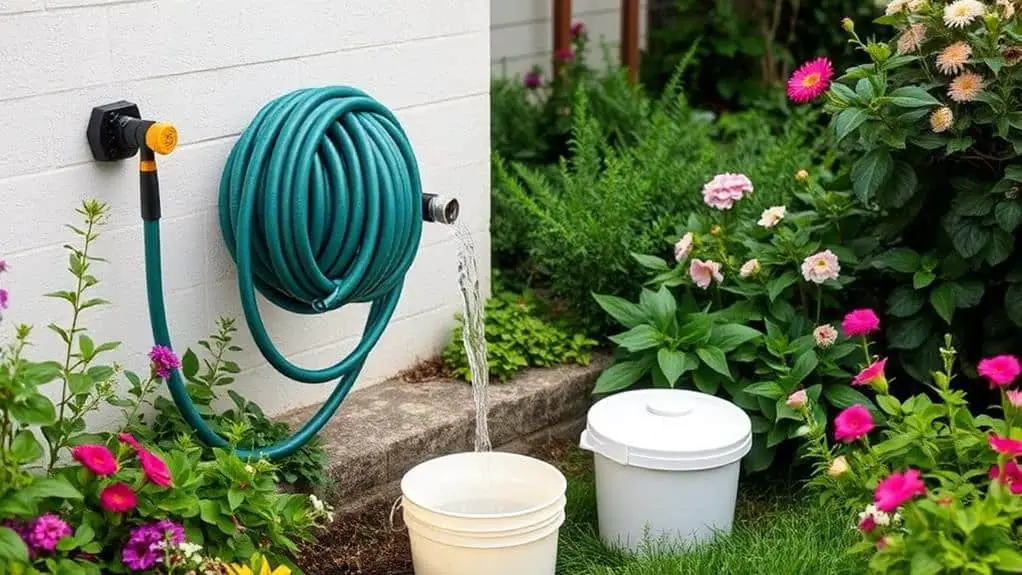
Draining your garden hose properly is essential for its longevity and functionality.
Here's a simple method to make it easy: Start by detaching the hose from the spigot. Elevate one end of the hose while keeping the other end lower. This allows gravity to help with water drainage methods.
Walk the length of the hose, keeping it elevated to guarantee complete drainage. Pay special attention to bends or kinks; water can get trapped there. Squeeze the nozzle to expel any leftover water.
Effective hose drying techniques prevent mold growth and freezing. Remember, seasonal maintenance like this extends your hose's lifespan and maintains its integrity.
Always store your hose fully drained to avoid deterioration over time.
Coiling Techniques
When coiling your garden hose, make certain to create loops with a diameter of about three feet to prevent kinks and guarantee easy storage.
It's best to do this in warm weather, as colder temperatures can make the hose stiff and more likely to crack.
Remember to avoid sharp bends and neatly coil the hose to prevent tangling, which will help keep it in good condition.
Proper Coiling Method
To efficiently manage your garden hose, mastering the proper coiling technique is essential. Start by choosing the right coil type for your hose materials. For most hoses, aim for a diameter of about three feet when coiling to avoid kinks.
Coiling frequency matters too—do it regularly, especially in warm weather, as the hose is more flexible.
Use the "over-under" technique: alternate the direction of each loop to prevent tangling. Be sure to avoid sharp bends to prevent internal damage.
Preventing Hose Kinks
Preventing hose kinks starts with mastering effective coiling techniques. First, aim for a coil diameter of about three feet to maintain hose flexibility and avoid kinks.
I recommend using the "figure-eight" coiling technique. This method alternates the direction of the coils, preventing twists and tangles. Always coil your hose when the weather is warm, as this improves flexibility and reduces the risk of sharp bends.
Avoid coiling the hose too tightly, which can create stress points and lead to permanent damage over time.
For storage, use materials like a hose reel or a holder. These tools keep your hose organized and help it maintain its shape, preventing future kinks.
Storage Locations
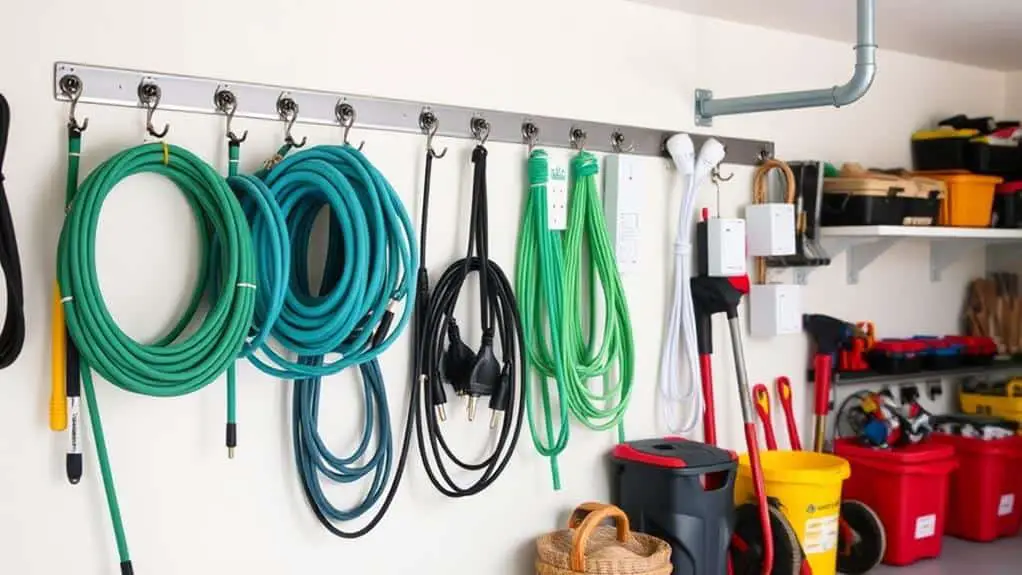
Choosing the right storage location for your garden hoses and cords is essential to ensuring their longevity and functionality. Indoor storage is a great option, especially in places like a shed or basement, which can keep them warm and safe during colder months.
Seasonal storage needs to account for climate considerations. Avoid leaving hoses and cords outdoors where they can be damaged by harsh weather. Instead, designate a dry, shaded area to minimize moisture buildup and prevent mold.
Use wall-mounted hose hangers or shelves to keep everything organized and off the ground. Regularly check your storage spot for signs of dampness or pests. This way, your garden tools will stay in good shape and ready for use whenever you need them.
Benefits of Proper Storage
When we store our garden hoses and cords properly, we can make them last longer by avoiding kinks and tangles.
Not only does this help us keep our garden space safer by reducing tripping hazards, but it also keeps everything tidy and easy to find.
This way, we can save time and work more efficiently during our gardening projects.
Increases Equipment Longevity
Proper storage of garden hoses and cords greatly boosts their longevity by preventing common issues like kinks and tangles, which often lead to wear and tear.
By keeping hose materials and cord types organized, you minimize their exposure to harsh environmental factors that can cause cracking or deterioration.
Regular maintenance, such as checking for damage and cleaning storage areas, helps identify issues early and avoids costly replacements.
Using storage solutions like reels or hooks minimizes stress on hoses and cords, allowing for gentle coiling rather than sharp bends.
Properly stored hoses and cords are also less likely to accumulate dirt and debris, which can affect performance.
- Extend lifespan
- Reduce wear and tear
- Minimize exposure to elements
- Prevent dirt and debris buildup
- Simplify maintenance
Enhances Garden Safety
Storing garden hoses and cords properly not only extends their lifespan but also greatly enhances garden safety.
When hoses and cords are neatly organized, the risk of tripping hazards decreases considerably. A tidy garden layout minimizes accidental tangling and snags, making it safer to move around. Plus, it enhances outdoor aesthetics, creating a more inviting space.
Using designated holders or reels keeps hoses and cords off the ground, preventing them from being run over by lawnmowers or other equipment. This not only extends their life but also avoids accidents.
Prevents Space Clutter
By effectively storing garden hoses and cords, you'll dramatically reduce space clutter in your outdoor areas.
This not only improves space efficiency but also boosts the visual appeal of your garden.
When everything has its place, it's easier to find what you need, enhancing outdoor organization.
Proper storage prevents tangling and damage, extending the lifespan of your hoses and cords.
Plus, a clutter-free space is safer, reducing tripping hazards.
Here are some benefits of proper storage:
- Maximizes usable space
- Easier to locate tools and equipment
- Prevents tangling and damage
- Reduces tripping hazards
- Encourages regular use and maintenance
Frequently Asked Questions
How Do You Store Garden Hoses Neatly?
To store garden hoses neatly, I use hose storage solutions like creative hose hangers and reels. These garden organization tips help keep my hoses tangle-free, accessible, and protected from damage, ensuring they last longer.
How Do You Store Cords Hoses to Avoid Strain Twists and Kinks?
I manage cords and hoses by coiling them in large loops and using reels or hooks for storage. This hose management technique prevents kinks, while cord organization tips like PVC pipes keep everything tidy and strain-free.
How to Properly Roll up a Garden Hose?
To properly roll up a garden hose, I first drain it completely. For effective garden hose care, I coil it neatly, avoiding kinks. Exploring hose reel options helps maintain shape. These hose maintenance tips guarantee longevity.
How Do You Loop a Garden Hose?
To loop a garden hose, I coil it to about three feet in diameter, guaranteeing each loop lies flat. I pay attention to the hose length, materials, and fittings to avoid kinks and guarantee longevity.
Conclusion
By keeping your garden hose and cords organized with these tips, you'll make your gardening tasks easier and more enjoyable. Using hooks, reels, and proper coiling techniques not only saves space but also extends the life of your equipment. Remember to store everything in a dry, shaded spot and check for damage regularly. With just a bit of effort, you can keep your garden neat and always ready for action. Happy gardening!

